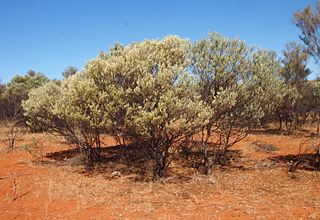
Acacia colei is a perennial bush or tree native to northern Australia and southern Asia. A common name for it is Cole's wattle. Acacia colei blooms from May through September and the flowers are bright yellow.

Acacia cuthbertsonii is a perennial shrub or tree native to arid parts of inland and north western Australia.

Acacia argyraea is a shrub belonging to the genus Acacia and the subgenus Juliflorae that is endemic to tropical parts of northern Australia.

Acacia elachantha is a shrub belonging to the genus Acacia and the subgenus Juliflorae. It is native to arid parts of central and northern Australia.
Acacia epedunculata is a shrub belonging to the genus Acacia and the subgenus Juliflorae that is endemic to a very small area in arid parts of western Australia.

Acacia fauntleroyi is a shrub or small tree belonging to the genus Acacia and the subgenus Juliflorae that is endemic to a part of south western Australia.

Acacia hamersleyensis, also known as Karijini wattle or Hamersley Range wattle, is a tree or shrub belonging to the genus Acacia and the subgenus Juliflorae. It is endemic to a small area in central Western Australia.

Acacia heteroneura is a shrub belonging to the genus Acacia and the subgenus Juliflorae that is endemic to western Australia.

Acacia hilliana, commonly known as Hill's tabletop wattle but also known as sandhill wattle and Hilltop wattle, is a shrub belonging to the genus Acacia and the subgenus Juliflorae. It is native to northern Australia.

Acacia levata is a shrub belonging to the genus Acacia and the subgenus Juliflorae that is endemic to small arid area of western Australia.

Acacia stipuligera is a tree or shrub belonging to the genus Acacia and the subgenus Juliflorae. It is native to arid and tropical parts of northern Australia.

Acacia dictyophleba, also known as the sandhill wattle, waxy wattle and feather veined wattle, is a shrub belonging to the genus Acacia and the subgenus Phyllodineae. The Nyangumarta peoples know the plant as Langkur or Lungkun and the Thalanyji know it as Jabandi.

Acacia glutinosissima is a shrub belonging to the genus Acacia and the subgenus Phyllodineae that is endemic to western Australia.

Acacia stellaticeps, commonly known as the Northern star wattle, poverty bush and glistening wattle. Indigenous Australians the Nyangumarta peoples know the bush as pirrnyur or pirrinyurru and the Ngarla peoples know it as panmangu. It is a shrub of the genus Acacia and the subgenus Plurinerves.

Acacia barringtonensis, commonly known as Barrington wattle, is a shrub belonging to the genus Acacia and the subgenus Phyllodineae endemic to New South Wales.

Acacia costiniana, commonly known as Costin's wattle, is a shrub belonging to the genus Acacia and the subgenus Phyllodineae that is endemic to eastern Australia.

Acacia ingramii, commonly known as Ingram's wattle, is a shrub belonging to the genus Acacia and the subgenus Phyllodineae that is native to parts of north eastern Australia.

Acacia saliciformis is a shrub or tree belonging to the genus Acacia and the subgenus Phyllodineae native to eastern Australia.

Acacia kydrensis, commonly known as Kydra wattle, is a shrub of the genus Acacia and the subgenus Phyllodineae that is endemic to south eastern Australia.

Acacia mariae, commonly known as golden-top wattle or crowned wattle, is a species of wattle native to central New South Wales.



















